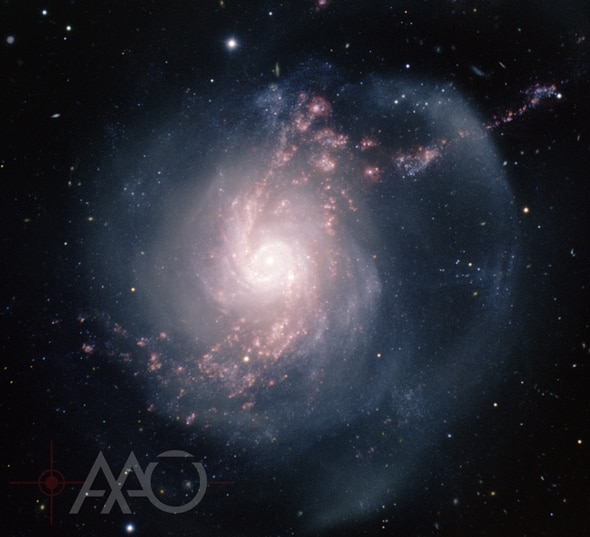Create a free profile to get unlimited access to exclusive videos, sweepstakes, and more!
NGC 3310, Its Arm Wide

Every now and again I find a spiral galaxy I’ve never heard of before, and I get two simultaneous and mutually annihilating thoughts: 1) How did I never see this before?, and b) there a bazillion spiral galaxies in the sky, so you can’t know them all!
Maybe not, but I can find them one by one and show them to you. Especially when they’re this cool.
The image above is the lovely NGC 3310, a spiral about 50–60 million light-years away. That’s not exactly in our neighborhood, but it’s close enough that with a good ‘scope a lot of detail can be seen.
The image was taken with the Gemini North 8.2 meter telescope, and the filters used show stars as white and blue, and warm hydrogen gas as pink.
To an astronomer’s eye, this galaxy fairly screams “recent collision and subsequent burst of star formation.” And that’s indeed the case: Maybe 100 million years ago, a smaller galaxy passed very close (possibly even through) NGC 3310. When that happens, the gravitational interaction can stir up the gas in the galaxies, causing a wave of star birth. That’s the pink gas: Hydrogen that’s busily making stars, some of which are massive and hot enough to excite the gas, which glows characteristically in the red part of the spectrum.
In fact, lots of clusters of stars were formed after the collision. By examining those stars, astronomers can figure out how long ago the clusters formed; as the stars age, the most massive ones explode as supernovae. We’re pretty good at understanding how rapidly stars age, so by looking at the most massive ones that haven’t yet exploded, an age of the cluster and therefore the time since the collision can be determined.
But there’s more. Pointing off at an angle to the upper right is a long line of hydrogen. That looks to me to be a tidal tail, a thin streamer that gets pulled away as the smaller galaxy moves off. These are very common in galaxy collisions. That’s another huge piece of evidence that NGC 3310 is still recovering from the cosmic wreck. Also, the blue arm to the upper right is off-center, patchy, and more diffuse than I’d expect in a normal, undisturbed galaxy.
That’s why I could tell right away a collision had occurred. I poked around to find more observations of NGC 3310 and found a lovely one by Hubble.
I had to rotate it to match the orientation of the Gemini image. It took me a while to figure out how much to rotate it: The Hubble field of view is smaller, and the filters used were different. The galaxy detail looks quite different in the two shots! That’s because Hubble didn’t use a filter that emphasizes the hydrogen gas, so it’s much fainter. Also, Hubble has higher resolution—features are sharper—but it has a much smaller mirror than Gemini (2.4 versus 8.2 meters) so in general the image isn’t as “deep”; that is, it doesn’t see features quite as faint.
I was most surprised by how the center of the galaxy looks so wildly different in the two images. The elliptical ring just around the galaxy center is made of stars and gas, and is visible in both shots. But the Hubble image shows more detail, including material interior to the ring on the right side, which threw my eye off as I tried to rotate the image to match it. Happily there were stars and patchy gas clouds that were seen in both, so I could get a good estimate of the angle.
Let your eye wander over both and try to pick out what matches and what doesn’t (hint: the red star at the bottom of the Hubble photo is the pinkish one about halfway from the center to the galaxy edge in the Gemini shot). It’s interesting to compare and contrast the same object seen in different ways by different telescopes.
Which is precisely why we observe astronomical objects multiple times. We can use a telescope that can see fainter objects, or at higher resolution, or use a filter that picks out star formation, or high-mass stars, or very hot gas. All of these methods are like chapters in a book that all tell part of the story: 1hat a galaxy is.
Tip o’ the Lindblad resonance to my pal Amanda Bauer.


























